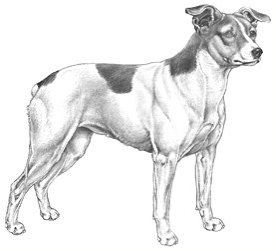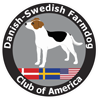 FEDERATION CYNOLOGIQUE INTERNATIONALE (AISBL)
FEDERATION CYNOLOGIQUE INTERNATIONALE (AISBL)
SECRETARIAT GENERAL: 13, Place Albert 1er B – 6530 Thuin (Belgique)
FCI-Standard n° 356 / 25. 07. 2009 / GB
Danish/Swedish Farmdog
(Dansk/Svensk
Gårdhund)

Translation: Renée Sporre-Willes in collaboration with Jennifer Mulholland.
Origin: Denmark / Sweden
Date of Publication of the Original Valid Standard: 26.03.2009
Utilisation: Farm- and companion dog
Classification: |
Group 2 |
Pinscher and Schnauzer, Molossoid breeds – Swiss Mountain and Cattle Dogs. |
Section 1.1 |
Pinscher type |
|
Without working trial. |
||
Brief Historical Summary: Recognised in Denmark and Sweden in 1987 under the breed name Danish-Swedish farmdog. The breed has been known for a long time on farms in Denmark and Sweden. The farmdog is used as a watchdog, ratter and companion.
General Appearance: A small, compact and slightly rectangular dog. Known to mature late.
Important Proportions: The body should be slightly rectangular, 9:10. The proportions between depth of chest and height at withers should be 1:2.
Behaviour Temperament: Alert, attentive and lively.
Head
Head should be triangular in shape and a bit small in proportion to body.
Cranial Region:
Skull: Rather broad and slightly rounded.
Stop: Well defined.Facial Region:
Nose: Colour in accordance with colour of patches.
Muzzle: Well developed and gradually narrowing towards nose but must not give a snipy impression. Muzzle slightly shorter than the skull. Nosebridge straight.
Jaws/teeth: Jaws strong. Scissors bite with even and well developed incisors. Pincer bite tolerated.
Cheeks: Pronounced without exaggeration.
Eyes: Medium sized, slightly rounded, neither protruding nor sunken. Attentive and kind expression. Dark eye colour in dogs with black patches. Slightly lighter eye colour permissible in dogs with yellow or liver brown patches.
Ears: Medium sized. Rose or button, in both cases the fold should be just above the skull. Button ears: The tips should lie close to cheeks.
Neck
Of medium length, strong and slightly arched. No throatiness.
Body
Compact with good substance.
Loin: Short, broad and slightly arched.
Croup: Slightly rounded.
Chest: Long, deep and roomy with well sprung ribs. Forechest well defined.
Underline and belly: Belly only slightly tucked up.
Tail
Not set too high. Long tail or naturally short (stumpy tail). Tail should be carried straight, with a slight curve or like a sickle.
Limbs
Forequarters:
General appearance: Forelegs straight and parallel. The front is broader than the ribcage.
Shoulders: Oblique.
Upper arm: Oblique.
Metacarpus (Pastern): Strong and springy.
Forefeet: Small, oval and not tightly knit.
Hindquarters:
General appearance: Well angulated knee and hock joints. Parallel and well muscled.
Upper thighs: Fairly broad.
Hind feet: See front feet.
Gait/Movement
Parallel and free.
Coat
Hair: Short and smooth. Harsh on body.
Colour: White dominating. Patches of different colours, sizes and combinations permissible, (black, tan, brown and different shades of fawn). With or without tan markings. Flecking permissible.
Size
Height at withers:
Males 34 to 37 cm
Females 32 to 35 cm
Tolerance +/- 2 cm.Faults
Any departure from the foregoing points should be considered a fault and the seriousness with which the fault should be regarded should be in exact proportion to its degree and its effect on the health and welfare of the dog.
- Elegant general appearance.
- Narrow in front.
- Low on legs.
- Lack of depth in chest.
- Flat or short ribcage.
- Steep croup.
- Prick ears.
- Neck too long.
- Curled tail or tail carried flat on back.
Disqualifying Faults
Aggressive or overly shy.
Any dog showing physical or behavioural abnormalities shall be disqualified.
N.B.
Male animals should have two apparently normal testicles fully descended into the scrotum.
Click here to print the Standard
Breeding Ethics and Guidlines | Breeder Directory | Upcoming Litters | Available Puppies

